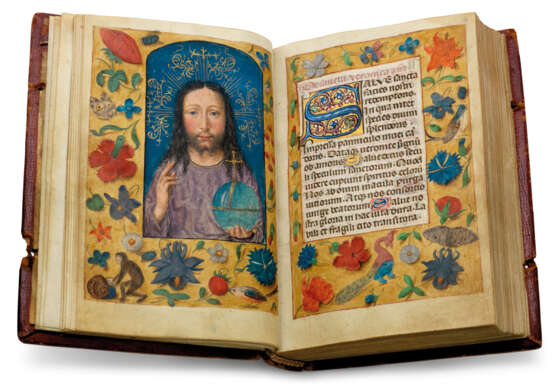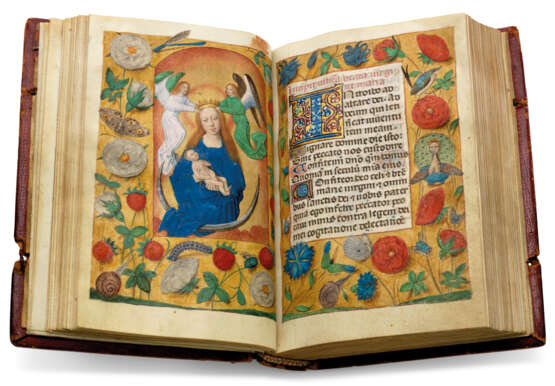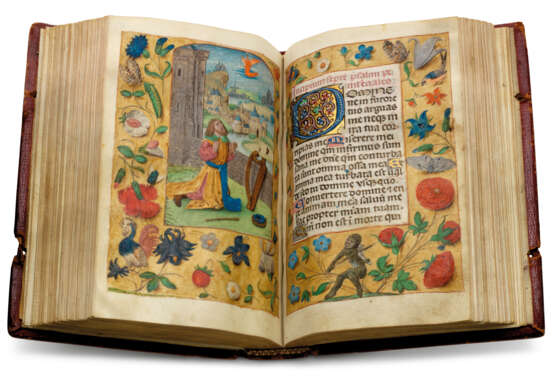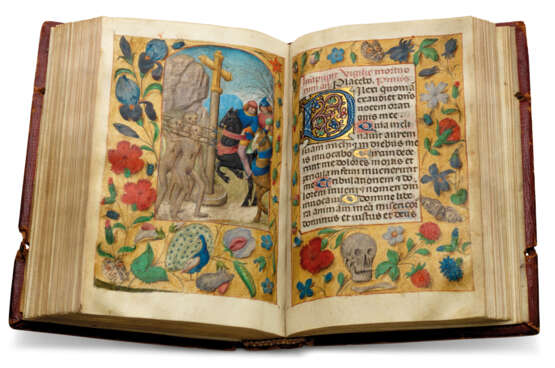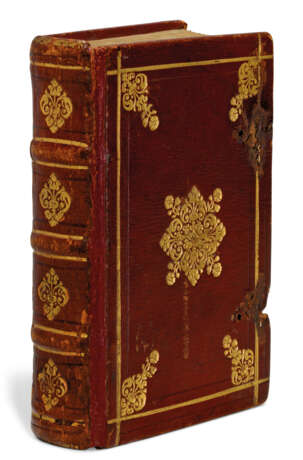ID 470078
Lot 36 | Bruges artist (active c1490-1500)
Estimate value
£ 50 000 – 80 000
Book of Hours, Bruges, c.1490-1500
BOOK OF HOURS, use of Rome, in Latin, illuminated manuscript on vellum [southern Netherlands, perhaps Bruges, c.1490-1500]
A delightful Book of Hours closely connected to another at the Royal Monastery of El Escorial: the work in our manuscript recalls that of the Master of Janneke Bollengier and the Master of Edward IV.
105 x 75mm. ii + 168, complete, modern pencil foliation, 17 lines, ruled space: 76 x 54mm, 2-line illuminated initials throughout, 10 historiated initials with three-quarter scatter borders of flowers, fruit, insects and grotesques, six full-page arch-topped miniatures facing six large illuminated initials within full borders as before (slight rubbing to some miniatures, light dampstaining to the outer margins across the manuscript, faint marginal wear elsewhere, thumbing). 17th-century Spanish red morocco gilt, edges gilt (lacking clasps, upper joint repaired).
Provenance: (1) Written and illuminated in Flanders, with liturgy for the use of Rome. The calendar, which is not particularly full, nevertheless has a distinct Bruges character: saints in red include SS Armand and Vedast (6 February), Boniface (5 June), Basil (14 June), Eligius (25 June) and Donatian (14 October). The ‘distinctive’ appearance of St Alexius among monks and hermits in the litany of the Escorial Hours remarked upon by Maryan Ainsworth and Thomas Kren (see the Illumination paragraph below) is mirrored here. (2) The final flyleaf is now a pastedown, but the verso bears an inscription in a ?17th-century hand (?‘Dos cosas mu[s]ica…’); the binding is likely Spanish from the same period. (3) Sotheby’s, 10 December 1980, lot 117.
Content: Calendar ff.1-12; prayer to the Holy Face ff.14-15; Hours of the Cross ff.17-22v; Hours of the Holy Spirit ff.23-27v; Mass of the Virgin including Gospel extracts ff.29-38v; Hours of the Virgin, use of Rome ff.40-101v; Penitential Psalms and Litany ff.103-121v; Office of the Dead ff.123-157; Obsecro te ff.158-161; O intemerata ff.161v-163; Athanasian Creed ff.164-167; ruled blank f.168.
Illumination: Elements of the programme of illumination connect our manuscript very closely to a Bruges Book of Hours from 1486 in the library of the Royal Monastery of El Escorial (Vitr. 12): the composition and palette of both the full-page Crucifixion and Annunciation miniatures are near-identical, the historiated initial depicting the Massacre of the Innocents in our manuscript distils a full-page composition in the Escorial Hours, and the style and staging of the insects, pea pods, grotesques and flowers in the scatter borders is also directly comparable, down to the repetition of certain motifs. Previously attributed in their entirety to Gerard David, the 15 miniatures in the Escorial Hours are now thought to have been largely the responsibility of another artist, identified by Bodo Brinkmann as the Master of Edward IV, with Gerard David responsible for a campaign of completion and repainting, chiefly of the faces and hands, of all the miniatures apart from the Virgin and Child (which is accepted to be entirely the work of David; see Brinkmann, Die flämische Buchmalerei am Ende des Burgunderreichs, 1997, pp.143-148, for discussion of the Escorial Hours). Maryan Ainsworth and Thomas Kren are not completely convinced by Brinkmann’s attribution of the majority of the work in the Escorial Hours to the Master of Edward IV, citing a certain lack of attention to detail and weaker handling of the settings (Kren and McKendrick (eds.), Illuminating the Renaissance, 2003, no 99); thus leaving anonymous the illuminator responsible for these and, possibly, part of the illumination of our own Hours.
Some of the miniatures in the present manuscript, which are not repainted as they are in the Escorial Hours, do recall the work of the Master of Edward IV: characteristic is the saturated palette of azure, salmon, green lake and grey-blue of the Crucifixion and Three Living and Three Dead miniatures, as well as the rather swarthy, almost careworn, male faces, with large deep-set eyes, shadowy cheekbones and straggling hair seen in the figures appearing at the Crucifixion around the foot of the cross, and in the Three Living. Other elements of the programme of illumination point elsewhere. Like the Escorial Hours, there is likely to be more than one hand at work in our manuscript: artists working during the golden age of Flemish manuscript illumination in the decades either side of 1500 frequently collaborated in this way. The cross-hatching in the ripples of the draperies and the darkly-flushed cheeks, fading into softly-curling facial hair, of Christ as Salvator mundi are closely comparable with another iteration of this popular subject in the Hours of Janneke Bollengier (Mons, Trésor de la Collégale Saint-Waudru, ms.65, f.249v; see Smeyers and Van der Stock (eds.), Flemish Illuminated Manuscripts, 1475-1550, 1996, ex. cat. no 39). The style of the Master of Janneke Bollengier, who takes his name from an Hours made for the grand-daughter of Jacques le Boulengier (d.1510), equerry to Charles the Bold, might also be identified in the gentle face of our Virgin (f.28v) with her rather long nose, which recalls the Annunciate Virgin in the Bollengier Hours (f.57v). Our own Annunciate Virgin looks like another in a miniature by Bollengier in the Arenberg Hours from the Beck collection (sold Sotheby’s, 16 June 1997, lot 32).
The subjects of the full-page miniatures are as follows: Christ as Salvator mundi f.13v; Crucifixion f.16v; Virgin and Child f.28v; Annunciation f.39v; David in Prayer f.102v; the Three Living and the Three Dead f.122v.
The subjects of the large historiated initials are as follows: Pentecost f.23; Visitation f.56; Nativity f.66; Annunciation to the Shepherds f.70; Adoration of the Magi f.74; Presentation in the Temple f.78; Massacre of the Innocents f.82; Flight into Egypt f.89; Blessing of the Virgin f.94; and the Pietà f.158.
| Genre: | Religious genre |
|---|
| Genre: | Religious genre |
|---|
| Address of auction |
CHRISTIE'S 8 King Street, St. James's SW1Y 6QT London United Kingdom | |
|---|---|---|
| Preview |
| |
| Phone | +44 (0)20 7839 9060 | |
| Buyer Premium | see on Website | |
| Conditions of purchase | Conditions of purchase |
